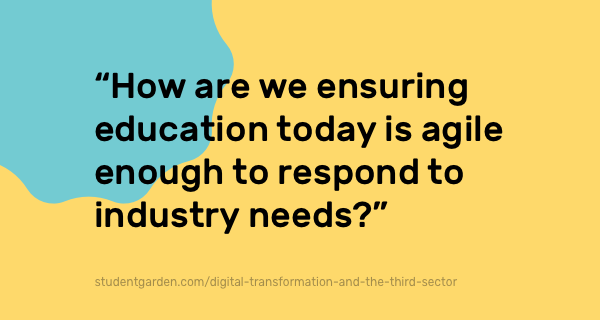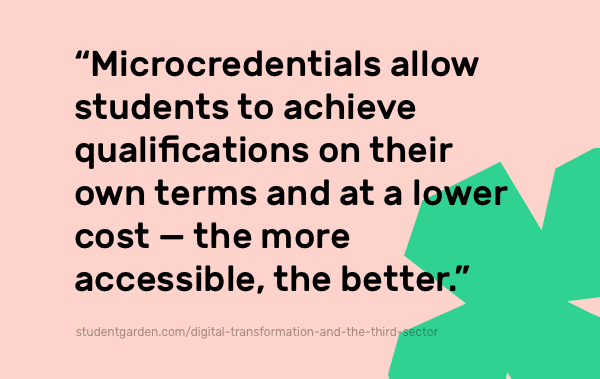Digital Transformation & the Third Sector: EduGrowth Melbourne EdTech Summit
I was lucky enough to visit the EduGrowth Melbourne EdTech Summit back in August. On day one, I heard from three powerhouses in the education community: Wendy Palmer from Global Studio and Deakin University, Nicholas Robert from Learning Vault, and Vivian Fan from Golden Education.
From these experts, I learned that the third sector is becoming an increasingly attractive option for learners who want to upskill and keep ahead in a competitive job market. People are looking beyond traditional tertiary pathways in their learning journey, and the third sector is a great way of enhancing their education and employability through accessible and flexible models.
As someone who is passionate about accessible learning, this session was fascinating and so valuable! Keep reading for my key insights and takeaways from the session that you can implement in your own education marketing.
What is the third sector?
If you’ve never heard of the third sector before, don’t worry! It’s an umbrella term that refers to everything that doesn’t fit under the label of ‘public sector’ or ‘private sector’ — basically, the section of society comprising of non-governmental, non-profit groups or organisations. Think charities, volunteering services, community groups, cooperatives, private research institutes (not including universities), and social enterprises.
How is the third sector relevant to education?
The third sector is an important avenue for education services that exists outside of the traditional education sector. There are so many important businesses that operate outside of the key institutions, and it’s time we started paying attention!
With the smaller size and agility of education providers in the third sector compared to traditional pathways, they can be proactive and move quickly — characteristics we all strive for in this industry.
These providers also often focus on shorter courses and quick upskilling, which is perfect for those looking for additional professional development outside of a traditional tertiary setting.

What can we learn from the third sector?
The greatest question we can ask ourselves from the third sector is:
How are we ensuring education today is agile enough to respond to industry needs?
Across the sector as a whole, there is a slowness to launch degrees. It’s a process that requires planning, curriculum development, and the consultation of academic boards.
With shorter programs, however, we allow ourselves to be agile.
Balancing between academic and personal development
Employers are saying that students are not job-ready in this post-pandemic environment, so it’s more important than ever to strike a balance in the content offered in each curriculum between academic and personal development. There is also increasing demand from the industry to become more involved in the upskilling process in order to create a strong foundation for the future of workplaces and education.
While the industry has traditionally looked at short courses and microcredentials as a way for universities to cannibalise themselves, that only works on the assumption that the same demand exists for full degrees as quick upskilling courses. In reality, there’s a market for both!
Changing the mindset around microcredentials
Microcredentials are termed as a ‘stackable’ course type that can act as a pathway into a university degree. They’re perfect for learners seeking a specific set of skills or interested in a very niche subject. You can read more about microcredentials and their benefits here!
In this session, Wendy Palmer spoke to Deakin’s goal to change the commonly held mindset that not completing a degree equates to being a ‘drop-out’. I was really impressed hearing that Deakin is reframing microcredentials as a way to allow students to achieve qualifications on their own terms and at a lower cost — the more accessible, the better.
Wendy also spoke about the importance of education key industry operators around short courses and microcredentials as equally valuable as full degrees. It just depends on the person and their overall education goals. For example, Wendy mentioned the possibility of students upskilling their old qualifications with microcredentials, which opens up the possibility for retargeting campaigns to graduations of over three years. After all, as we enter a recession more people will be looking for ways to get better roles (and better pay).

Digital transformation and microcredentials
Moving forward, it’s exciting to think of how the education industry will progress once short courses and microcredentials are more embraced.
From a practical perspective, we know that employers want to know the specifics: what are the outcomes of the short course, and how much time is put into each (for example, 100 hours of practice on a specific platform). How cool would it be to see universities partnering with marketing automation platforms to create industry-ready courses like ‘MA001: Fundamentals of Marketo’?
All this makes me think, though — if we’re moving toward a fully student-first model, why do we have short courses on one website, online on another, and then regular courses on another? A more streamlined approach will enhance the student experience and deliver greater real-world results.
In all, Wendy says the way we can drive change is by “helping industry and universities work together in a more agile way, to quickly bring ideas, tech and skills together — that would help fill the skills gap”.
